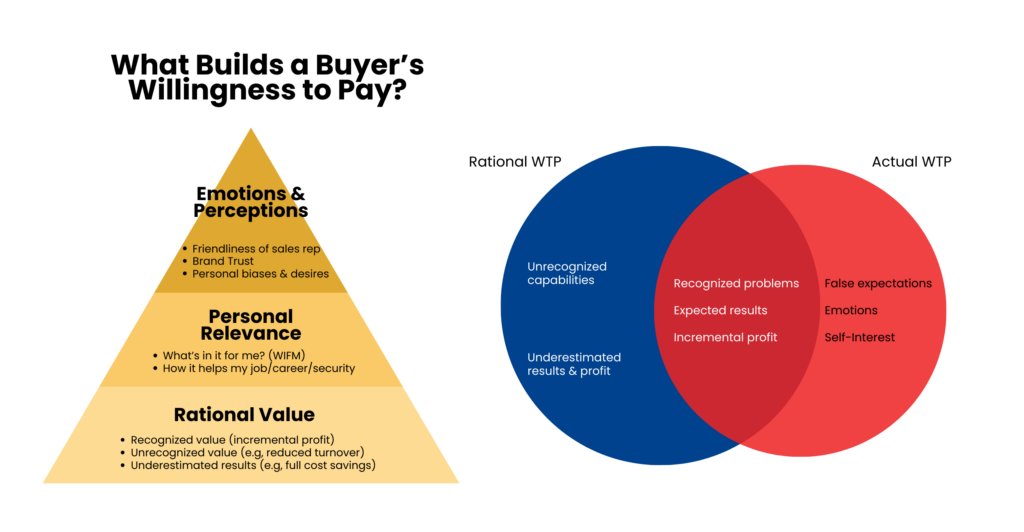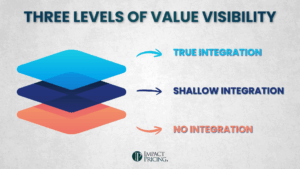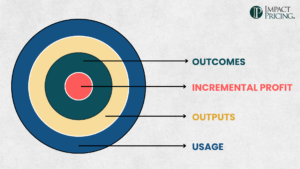You can listen to the full audio version of this blog we call — Blogcast.

Charging what a buyer is willing to pay is the single profit-maximizing price. It’s impossible to do better. But, it’s also impossible to know exactly how much anyone is willing to pay.
In an effort to better understand and, more importantly, influence Willingness to Pay (WTP), let’s examine rational vs. actual WTP. To be clear, the word rational is used in the economic sense, meaning the buyer knows all relevant information.
First, in B2B, value is measured in incremental profit. A rational company would know all of the problems a product would solve, understand the results of solving them, and be able to calculate the amount of incremental profit it will achieve. Hence, a buyer’s rational WTP would be some fraction of the incremental profit. A rational company would not consider individual preferences or emotions. Only the capabilities that affect profit should influence WTP.
But of course, buyers aren’t rational. They are irrational in two ways: they don’t recognize some of the value they will receive, and value items irrelevant to incremental profit. You can see this in the Venn diagram. The Rational WTP circle is all about incremental profit. But the deep blue section is what a rational person would have considered, but wasn’t considered in the actual decision. The Actual WTP circle shows what a buyer considers. The items in the far right section were considered but don’t influence incremental profit. They shouldn’t have been. The intersection of the two circles shows the items where the buyer considered the rational characteristics.
Missing Value
Buyers don’t recognize all the value they will obtain for several reasons. They are buying a product to solve a specific set of problems. They analyze the solution to see how well it solves those problems. However, most products also solve other problems for their users. You may sell a machine that increases the productivity of a manufacturing line, and that’s why a buyer calls you. However, you may also improve employee satisfaction, reduce turnover, and save the company even more money. Think of lowering turnover as an unrecognized value in this case.
Buyers also often underestimate the results they will get. In the manufacturing machine example, the buyer will probably calculate the increased revenue from increased production, but do they remember to track the cost savings of less labor or overhead per unit?
Training your salespeople to sell value, not features, can minimize both unrecognized capabilities and underestimated results. Value is measured in incremental profit, and the better your sales team is at helping buyers calculate the incremental profit, the more your buyers are willing to pay.
Irrelevant Considerations
Buyers often consider items irrelevant to their company’s incremental profit but still impact WTP. They may believe your product has some capabilities that it doesn’t. Maybe they dreamed it up or misheard someone talking about it. Hopefully, your salespeople didn’t conjure it up.
This is where emotions fit into a decision. You’ve probably heard the phrase, “people buy based on emotion and justify based on logic.” That may be true. Companies that purchase items try to minimize the effect of emotions by issuing RFPs or using buying committees. However, we all know emotions still play a role. That’s why your salespeople become friends with buyers.
The individual employee’s self-interest can also influence a purchase decision. If your product makes that employee’s job easier, even when it isn’t the best choice for the company, they may still push for you.
Maximizing WTP
You can use all the information above to help maximize your buyers’ WTP. (Of course, don’t lie to your customers, please.)
You should know your buyer’s business well enough to help them see all of the highly profitable ways you help them, and then be able to help them calculate their incremental profit. This is what selling value means.
You should learn what each relevant employee (persona) cares about and be able to position your product to help that employee reach their goals.
You should have friendly, likable salespeople and definitely use behavioral economics when communicating prices.
A buyer’s actual WTP is built on what they rationally know about how your solution helps them increase profit, how your solution will help them personally, and how they feel about your company.
If you’d like help getting your salespeople to win more deals at higher prices, it’s what we do. We can help with all of the issues above except the friendly, likable part. That’s entirely up to you.
Share your comments on the LinkedIn post.
Now, go make an impact!
 Tags: pricing, pricing foundations, pricing metrics, pricing skills, pricing strategy, pricing value, value, value-based pricing, willingness to pay
Tags: pricing, pricing foundations, pricing metrics, pricing skills, pricing strategy, pricing value, value, value-based pricing, willingness to pay













